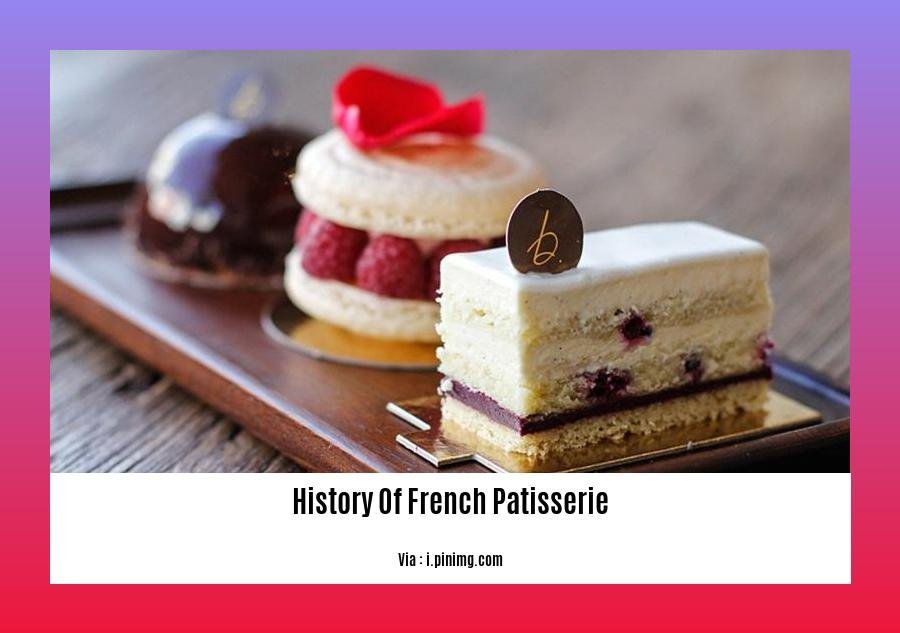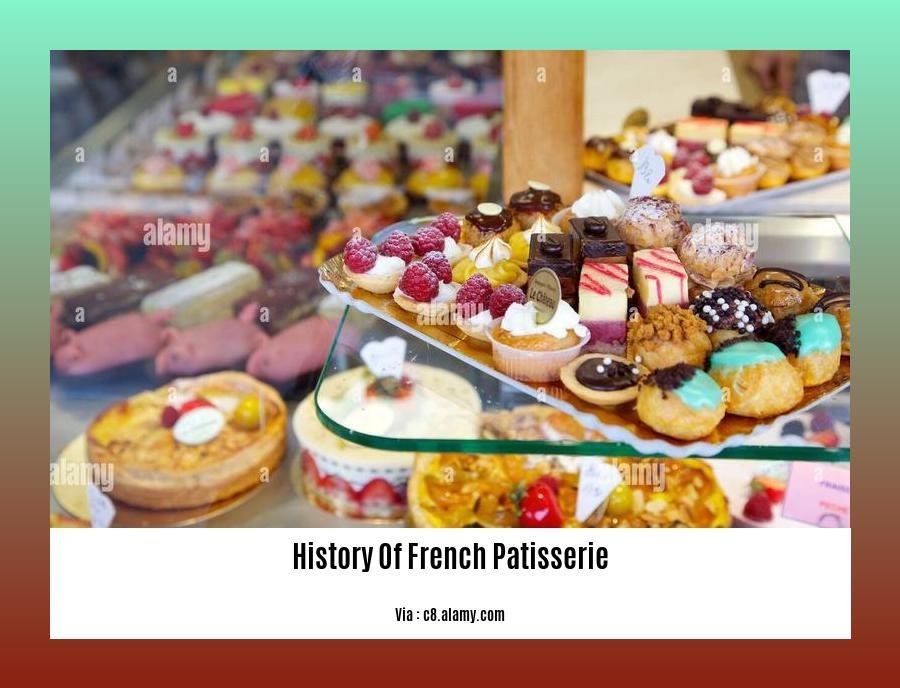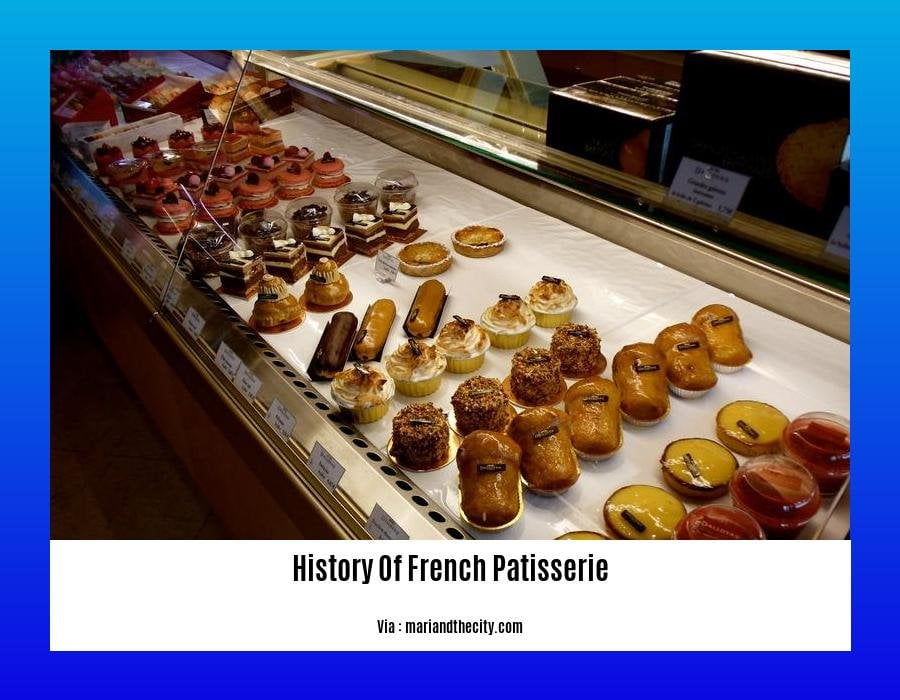Embark on a delectable journey through time as we delve into the rich history of French patisserie, a culinary art form that has captivated palates for centuries. From its humble origins in medieval kitchens to its transformation into a globally renowned tradition, French patisserie is a testament to the enduring power of culinary innovation and artistry. Join us as we uncover the fascinating stories, techniques, and influences that have shaped this exquisite craft, and discover why French pastries continue to ignite a passion in food enthusiasts worldwide. Bon appétit!
Key Takeaways:
- During the Middle Ages, there was a clear distinction between cooks and pastry cooks.
- Chocolate was introduced to France by Anne of Austria from Spain in the 17th century.
- French pastries originated from the desire for a sweet treat after a meal.
- Popelini invented the puff pastry in 1540, and in 1566, the oublies were renamed confectioners.
- In 1630, a French painter is credited with inventing the foliated pastry.
- Vatel, the cook of the Prince of Condé, created whipped cream in 1660, and the year 1686 marked the beginning of French café culture in France.
History of French Patisserie

From humble beginnings in medieval kitchens to its global recognition today, the history of French patisserie is a delectable journey through time.
The Birth of Indulgence:
- The Middle Ages marked the distinction between cooks and pastry cooks, setting the stage for culinary specialization.
Sweet Innovations:
- The 17th century brought chocolate to France, thanks to Anne of Austria.
A Cultural Movement:
- The demand for post-meal treats fueled the rise of French patisserie as a cultural phenomenon.
Baking Landmarks:
-
1540: Popelini’s creation of puff pastry revolutionized baking.
-
1566: Oublies transformed into confectioners, a testament to culinary evolution.
Artistic Influence:
- The foliated pastry emerged in 1630, attributed to a French painter’s creative genius.
Culinary Delights:
-
Vatel, the renowned cook, introduced whipped cream in 1660, delighting palates.
-
1686 marked the beginning of French café culture, a social hub for pastry enthusiasts.
French Patisserie Today:
- French pastries continue to captivate the world, a legacy built on centuries of innovation and artistry.
Are you intrigued by the journey of energy drinks through time? Dive into the history of energy drinks and discover the evolution of these stimulating beverages.
Have you ever wondered about the origin and evolution of French pastries? Embark on a delectable journey through the history of French pastries and uncover the secrets behind these culinary masterpieces.
Social and Cultural Influences
Throughout history, social and cultural influences have played a pivotal role in shaping the evolution of French patisserie. In the early days, pastries were a luxury reserved for the wealthy and powerful. However, as sugar became more affordable, pastries began to find their way onto the tables of ordinary people.
The rise of the French café culture in the 17th century created a new social space where people could gather to enjoy pastries and other confections. Cafés became a place to see and be seen, and they quickly became an important part of French culture.
The French Revolution also had a profound impact on patisserie. The overthrow of the monarchy led to a new era of social mobility, and pastries became a way for people to express their new-found freedom. New and innovative pastries were created, and patisserie became a symbol of the new republic.
In the 20th century, French pastries gained international recognition. This was due in part to the work of famous pastry chefs such as Gaston Lenôtre and Pierre Hermé. These chefs took traditional French pastries and elevated them to new heights. They also began to experiment with new flavors and techniques, and their work helped to revolutionize the world of patisserie.
Today, French pastries are enjoyed all over the world. They are a symbol of luxury, decadence, and celebration. And while they have evolved over the centuries, they remain true to their French roots.
Key Takeaways:
– French patisserie reflects the country’s rich history and culture.
– The rise of the French café culture helped to popularize pastries among all social classes.
– The French Revolution led to a new era of social mobility and innovation in patisserie.
– In the 20th century, French pastries gained international recognition due to the work of famous pastry chefs.
– Today, French pastries are enjoyed all over the world and remain a symbol of culinary excellence.
Sources:
– The History of French Pastries and Classic French Desserts
– The History of French Pastry and Confectionery
Analysis of Historical Recipes

Have you ever wondered about the rich history behind those delectable French pastries you savor? Join me on a delectable journey as we uncover the fascinating world of French patisserie and explore the art of analyzing historical recipes.
French pastry-making boasts a rich legacy, dating back to medieval times when cooks specialized as pastry cooks. Over the centuries, innovations like puff pastry and whipped cream transformed the culinary landscape, shaping the iconic pastries we know today.
As a culinary historian, I’m passionate about delving into the intricacies of these historical recipes. Analyzing them is like solving a culinary puzzle, piecing together the techniques, ingredients, and cultural influences that shaped each creation.
One of the most captivating aspects of this analysis is understanding the role of historical figures in shaping French patisserie. Marie-Antoine Carême, known as the “King of Chefs,” revolutionized the field with his intricate designs and refined flavors. His cookbook, “The Royal Parisian Pastry Chef,” became a guidebook for generations of pastry chefs.
Another crucial element is deciphering the nuances of traditional techniques. How did pastry chefs achieve those delicate layers in a croissant or the perfect glaze on an éclair? Analyzing these techniques allows us to appreciate the craftsmanship and skill that goes into each pastry.
Furthermore, understanding the social and cultural context of these recipes is essential. French pastries were often tied to special occasions, such as weddings and religious festivals. Analyzing their significance in these contexts provides a deeper appreciation for their cultural value.
Through the Analysis of Historical Recipes, we not only preserve the heritage of French patisserie but also gain insights into the evolution of culinary techniques, the influence of historical figures, and the cultural significance of these delectable creations.
Key Takeaways:
-
French patisserie has a rich history, evolving from medieval times to become a globally renowned culinary art form.
-
Analyzing historical recipes involves deciphering techniques, understanding cultural influences, and appreciating the craftsmanship of pastry chefs.
-
Historical figures like Marie-Antoine Carême played a pivotal role in shaping French patisserie through their innovations and cookbooks.
-
Traditional techniques, such as puff pastry and whipped cream, revolutionized the field and continue to be used in modern pastry-making.
-
Understanding the social and cultural context of these recipes provides insights into their significance beyond their culinary value.
-
Source 1: The History of French Pastries and Classic French Desserts
-
Source 2: The History of French Pastry and Confectionery
Legacy and Ongoing Impact of French Patisserie
Imagine yourself strolling through the cobbled streets of Paris, gazing upon the inviting displays of French pastries in patisserie windows. These bite-sized works of art, each with its own story to tell, have left an indelible mark on the culinary landscape. Join me as we explore the legacy and ongoing impact of French patisserie.
A Pastry Paradise
French pastries have captivated palates worldwide with their delectable flavors and intricate designs. The French take pride in their culinary heritage, and patisserie holds a special place in their hearts. From the buttery croissants and flaky mille-feuilles to the delicate macarons and creamy éclairs, French pastries are a feast for the senses.
Evolution of Techniques
The French have mastered the art of pastry-making, developing innovative techniques and perfecting traditional recipes over centuries. Puff pastry, a signature component of many French pastries, showcases the French knack for creating layers of crispy, golden pastry. Brioche, with its rich, buttery dough, is another testament to French pastry-making prowess.
Cultural Ambassadors
French pastries have become cultural ambassadors, representing France’s culinary excellence on the global stage. They are synonymous with luxury, sophistication, and indulgence. From the humble croissant, enjoyed as a morning staple, to the elaborate pièce montée, a centerpiece of special occasions, French pastries have become an integral part of French culture and cuisine.
Inspiration for the World
The influence of French patisserie extends far beyond its borders. Pastry chefs worldwide draw inspiration from the French masters, incorporating techniques and flavors into their creations. French pastry schools attract students from around the globe, eager to learn the secrets of this culinary art form.
Key Takeaways:
-
French pastries have evolved from humble beginnings to become symbols of culinary excellence.
-
Innovative techniques, such as puff pastry and brioche, showcase the French mastery of pastry-making.
-
French pastries have become cultural ambassadors, representing France’s culinary prowess worldwide.
-
The influence of French patisserie extends globally, inspiring pastry chefs and enthusiasts alike.
-
French pastry schools attract students from around the world, eager to learn the secrets of this culinary art form.
Sources:
-
The History of French Pastry and Confectionery
-
French pâtisseries: the origins of famous French delicacies
FAQ
Q1: What was the origin of French pastries?
A1: The history of French pastries can be traced back to the desire for a sweet treat after a meal. Initially, fruits and cheese were served as desserts, but pastries emerged to satisfy people’s lingering sweet cravings.
Q2: How did French pastry-making evolve over time?
A2: French pastry-making flourished during the Renaissance with the arrival of sugar from the Americas. In the 16th and 17th centuries, advancements in techniques like puff pastry, brioche, and fondant were introduced. These innovations laid the foundation for the diverse pastries enjoyed today.
Q3: Who were some notable figures in the history of French patisserie?
A3: Marie-Antoine Carême played a crucial role in the evolution of French pastry during the Napoleonic era. His cookbook, “The Royal Parisian Pastry Chef,” became a guidebook for French pastry techniques and influenced future generations of pastry chefs.
Q4: What is the cultural significance of French pastries?
A4: French pastries have become a symbol of France’s rich culinary heritage and are appreciated worldwide. They are a key component of French cuisine, often served at special occasions and celebrations. The expertise and artistry of French pastry chefs continue to inspire and influence pastry culture globally.
Q5: Where can I learn more about French patisserie?
A5: To delve deeper into the history and techniques of French patisserie, one can study with renowned pastry chefs like Christophe Felder and Sébastien Bouillet. Additionally, pastry and cake-making classes are offered in cities like Paris, Strasbourg, and Lyon.















